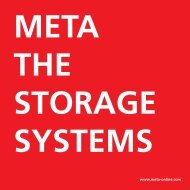You also want an ePaper? Increase the reach of your titles
YUMPU automatically turns print PDFs into web optimized ePapers that Google loves.
<strong>META</strong> General<br />
<strong>META</strong> Glossary<br />
Technical terms explained<br />
Adjusting screw<br />
The adjusting screw on the cantilever arms (<strong>META</strong> MULTISTRONG ®<br />
L+M) is a type of lift lock. When the screw is tightened, it causes a<br />
plate with two teeth to be pressed into the upright section and against<br />
the cantilever arm itself. This raises the arm slightly. Round materials<br />
therefore roll toward the uprights and the arm cannot be lifted off<br />
accidentally.<br />
Back stop<br />
Prevents pallets from being pushed through accidentally. Back stops are<br />
not to be used regularly as a push-through protection in the same way<br />
as pallet stops.<br />
Bay load<br />
Total load capacity of a rack bay. A bay is the area between two frames.<br />
The sum of the shelf loads one above the other should not exceed the<br />
permitted bay load. Bay load is affected by shelf height.<br />
Bracing beams<br />
Bracing beams are angle sections with one connector on right and left.<br />
They are used to reinforce boltless racks at defined intervals. The shelf<br />
is inserted in the folded angle of the beam. The standard reinforcement<br />
is the diagonal brace.<br />
Brackets<br />
These are used as reinforcements at specified positions on bolted racks.<br />
<strong>META</strong> brackets consist of an angled plate with integrated nuts, which<br />
makes assembly tremendously easier.<br />
Buckling length see "shelf height"<br />
Channel support<br />
For safe storage of mesh box pallets. These have angled foot-plates,<br />
which make them difficult to store directly in pallet racks. The channel<br />
supports guide the foot plates of the mesh boxes, which can then be<br />
safely set down on the beams.<br />
Clinched frames / shelves<br />
Clinching is a pressure-joining process used at <strong>META</strong> for producing its<br />
CLIP frames. With this process, the upright parts are force-fitted to<br />
the linking bars/panel. In this way, the pre-assembled frames are made<br />
highly stable and robust. Unlike frames with bolted or riveted linking<br />
bars, there are no obstructions to the insertion of shelves at any point.<br />
This process is also being used increasingly in shelving production. It has<br />
significant environmental advantages over traditional welding.<br />
Connector<br />
Hook block used for fastening a brace or beam to the upright section.<br />
The hook transfers the loads onto the upright section, and also<br />
reinforces the rack.<br />
Depth/longitudinal supports<br />
See "Supports". Longitudinal or depth supports are inserted, according<br />
to the shelf type.<br />
Diagonal reinforcement<br />
Reinforcing elements on the back of racks, consisting of diagonal bars.<br />
Diagonal reinforcing bars are used on shelving units and cantilever<br />
racks. This is a highly effective reinforcement method for supporting<br />
tensile forces.<br />
End stop<br />
For separating cantilever arms. Prevents round materials from<br />
accidentally slipping off (storage regulation BGR 234 for round<br />
materials)<br />
Galvanisation<br />
With electro-galvanisation, or zinc-coating, the parts to be coated are<br />
first cleaned with dilute acids, then dipped in a bath containing a salt<br />
solution of the coating metal (zinc). A current is then passed through<br />
the bath at low voltage. The electric current causes the chemical<br />
breakdown of the solution in the bath. The metal (zinc) separates out<br />
from the salt and is deposited in a thin layer on the part being coated.<br />
Locking pins<br />
Locking pins have to be inserted to prevent accidental lifting of the<br />
beams in the pallet rack.<br />
Picking tray<br />
For racks with tilted surfaces or roller strips, a picking tray is installed<br />
where the goods taken from the rack can be assembled.<br />
Polypropylene (PP)<br />
PP is resistant to almost all organic solvents and fats, as well as most<br />
acids and alkaline solutions. PP is odourless and gentle on the skin. It is<br />
suitable for applications in the foodstuffs and pharmaceutical sectors.<br />
It is physiologically harmless.<br />
Powder coating<br />
The powder coating supplied by <strong>META</strong> is an epoxy-polyester based<br />
powder coating. It provides optimal abrasion resistance and the highest<br />
possible surface quality. Even when used for storing foods, the plastic<br />
coating does not give off any substances that might have an unpleasant<br />
taste or smell, or which could be harmful to health. The coating process<br />
used is completely harmless to the environment. There are no chemical<br />
waste products. The water required is fully treated in a cleaning process<br />
circuit. No waste water is discharged into the sewage system.<br />
Pre-galvanisation<br />
The base material (steel) in the form of strips or sheets is cleaned by<br />
baking in a conveyor furnace, after which it is heat-treated, then passed<br />
through a bath of molten zinc. The desired amount of zinc coating is<br />
controlled and adjusted using the jet-stripping process. A crystalline<br />
structure forms as the zinc coat solidifies.<br />
Reinforcement<br />
Racks are reinforced either with diagonal braces (cross-braces) or with<br />
longitudinal reinforcers/beams. Diagonal braces are often used on<br />
shelving. On pallet racks, reinforcement is provided by the structural<br />
forces of the beams.<br />
Shelf height<br />
Indicates the distance between the top surface of the warehouse<br />
floor (or shelf) to the top edge of the shelf above. This distance is also<br />
referred to as the buckling length. If the distance between two shelf<br />
levels in the rack is greater, this is crucial for the structural design of the<br />
rack. Shelf height has a direct effect on the load capacity of a rack (→<br />
bay load).<br />
Shelf load<br />
Shelf load refers to the loading on one shelf level or shelf between two<br />
frames. The load should be evenly distributed over the whole surface.<br />
The total of the shelf loads is equal to the bay load.<br />
Spacer<br />
Connecting element between two racks. Used when assembling pallet<br />
racks, where it ensures a uniform gap between the different racks.<br />
Supports<br />
Supports are used for various reasons: With shelves, they can increase<br />
the load capacity. In general, they prevent sagging of the shelves. With<br />
stepped beams, they prevent hollowing out of the beams when under<br />
load. If chipboards are inserted, they prevent sagging and therefore<br />
breakage of the boards.<br />
Upright section<br />
Vertical load bearing element, which is given its geometry by cold<br />
forming. It is joined to the load-bearing frame by connecting elements<br />
such as linking bars or C-section braces. On boltless racks, it is the<br />
shelves and brackets which are the connecting elements. The uprights<br />
transfer the bay load to the warehouse's load-bearing floor.<br />
162





